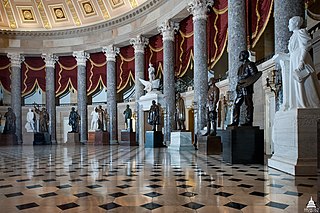
The National Statuary Hall is a chamber in the United States Capitol devoted to sculptures of prominent Americans. The hall, also known as the Old Hall of the House, is a large, two-story, semicircular room with a second story gallery along the curved perimeter. It is located immediately south of the Rotunda. The meeting place of the U.S. House of Representatives for nearly 50 years (1807–1857), after a few years of disuse it was repurposed as a statuary hall in 1864; this is when the National Statuary Hall Collection was established. By 1933, the collection had outgrown this single room, and a number of statues are placed elsewhere within the Capitol.

The National Statuary Hall Collection in the United States Capitol is composed of statues donated by individual states to honor persons notable in their history. Limited to two statues per state, the collection was originally set up in the old Hall of the House of Representatives, which was then renamed National Statuary Hall. The expanding collection has since been spread throughout the Capitol and its Visitor's Center.

John James Ingalls was an American Republican politician who served as a United States senator from Kansas. Ingalls is credited with suggesting the state motto and designing the state seal.
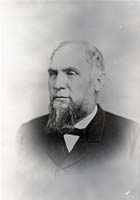
George Washington Glick was the ninth Governor of Kansas.

Charles Henry Niehaus was an American sculptor.

The United States Capitol building features a central rotunda below the Capitol dome. Built between 1818 and 1824, the rotunda has been described as the Capitol's "symbolic and physical heart".

Franklin Bachelder Simmons was a prominent American sculptor of the nineteenth century. Three of his statues are in the National Statuary Hall Collection, three of his busts are in the United States Senate Vice Presidential Bust Collection, and his statue of Ulysses S. Grant is in the United States Capitol Rotunda.
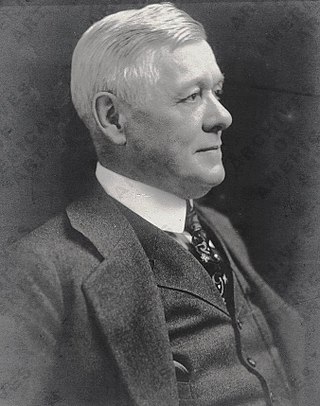
John Massey Rhind was a Scottish-American sculptor. Among Rhind's better known works is the marble statue of Dr. Crawford W. Long located in the National Statuary Hall Collection in Washington D.C. (1926).

The Hall of Columns is a more than 100-foot-long (30 m) hallway lined with 28 fluted columns in the south wing extension of the United States Capitol in Washington, D.C. It is also the gallery for 18 statues of the National Statuary Hall Collection.

The National Statuary Hall Collection holds statues donated by each of the United States, portraying notable persons in the histories of the respective states. Displayed in the National Statuary Hall and other parts of the United States Capitol in Washington, D.C., the collection includes two statues from each state, except for Virginia which currently has one, making a total of 99.

Henry Clay is a 1929 bronze sculpture by Charles Henry Niehaus depicting the lawyer and politician Henry Clay, installed in the United States Capitol in Washington D.C. as part of the National Statuary Hall Collection. It is one of two statues donated by the state of Kentucky. The statue was accepted into the collection by Virgil Chapman on March 3, 1929.

John M. Clayton is a 1934 marble sculpture depicting the American lawyer and politician of the same name by Bryant Baker, installed in the United States Capitol, in Washington D.C., as part of the National Statuary Hall Collection. It is one of two statues donated by the state of Delaware The statue was accepted in the collection by Robert G. Houston on June 6, 1934.
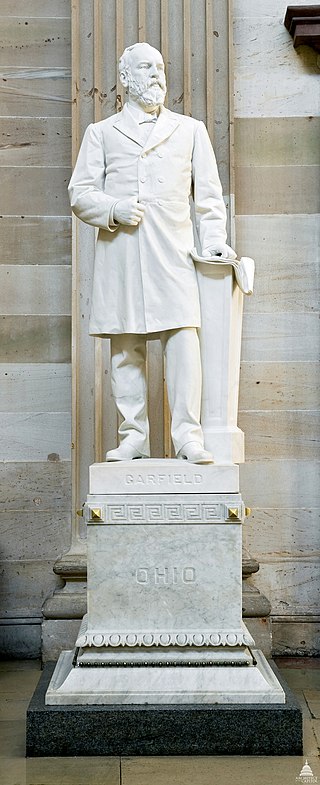
A statue of James A. Garfield by Charles Henry Niehaus stands in the United States Capitol's rotunda, in Washington, D.C., as part of the National Statuary Hall Collection. The marble statue was gifted by the U.S. state of Ohio in 1886.
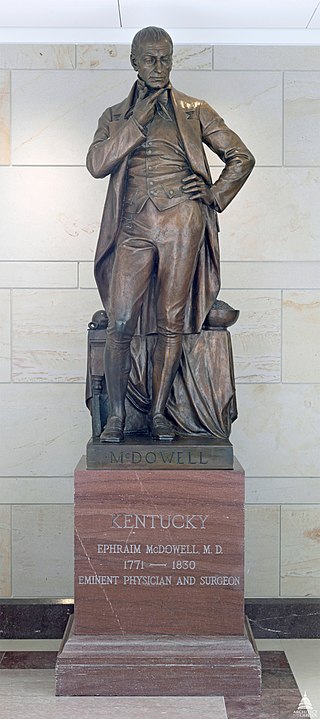
Ephraim McDowell is a bronze sculpture depicting the American physician and surgeon of the same name by Charles Henry Niehaus, installed in the United States Capitol Visitor Center, in Washington, D.C., as part of the National Statuary Hall Collection. The statue was gifted by the U.S. state of Kentucky in 1929.
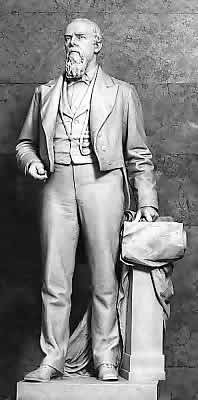
Oliver P. Morton is a 1900 marble statue of Governor Oliver P. Morton by Charles Henry Niehaus installed in the United States Capitol, in Washington, D.C., as part of the National Statuary Hall Collection. It is one of two statues donated by the state of Indiana. The statue was accepted into the collection on April 14, 1900, by Indiana Senator Albert J. Beveridge.

Julius Sterling Morton, also known as J. Sterling Morton, is a 1937 bronze sculpture of Julius Sterling Morton by Rudulph Evans, installed in the United States Capitol Visitor Center, in Washington, D.C., as part of the National Statuary Hall Collection. It is one of two statues donated by the state of Nebraska. The sculpture was accepted into the collection by Congressman Karl Stefan of Nebraska on April 27, 1937.

John Campbell Greenway is a 1930 bronze statue of John Campbell Greenway by Gutzon Borglum, one version of which was installed in the United States Capitol, in Washington D.C., as part of the National Statuary Hall Collection. It was one of two statues donated by the state of Arizona. The sculpture was unveiled by Senator Henry Ashurst of Arizona on May 24, 1930.
George Washington Glick is a marble sculpture depicting the American politician of the same name by Charles Henry Niehaus, formerly installed in Washington, D.C. as part of the National Statuary Hall Collection. The statue, which was gifted by the U.S. state of Kansas in 1914, was replaced with one depicting Dwight D. Eisenhower in 2003.

Equal Visibility Everywhere, also known as EVE, is a non-profit 501(c)(3) organization based in Miami, Florida. EVE was founded in 2010 by the psychologist and former college professor Lynette Long, with the mission "to achieve gender parity in the monuments, symbols, and icons, of the United States." Its ongoing projects include adding more statues of women to the National Statuary Hall Collection, creating new historical markers honoring America's heroes, adding images of women to America's paper currency and coins, increasing the number of women honored on stamps and Google Doodles, and increasing the number of female character balloons in parades.

The statue honoring aviator Amelia Earhart was unveiled in the United States Capitol in Washington, D.C., representing Kansas in the National Statuary Hall Collection on July 27, 2022.

















